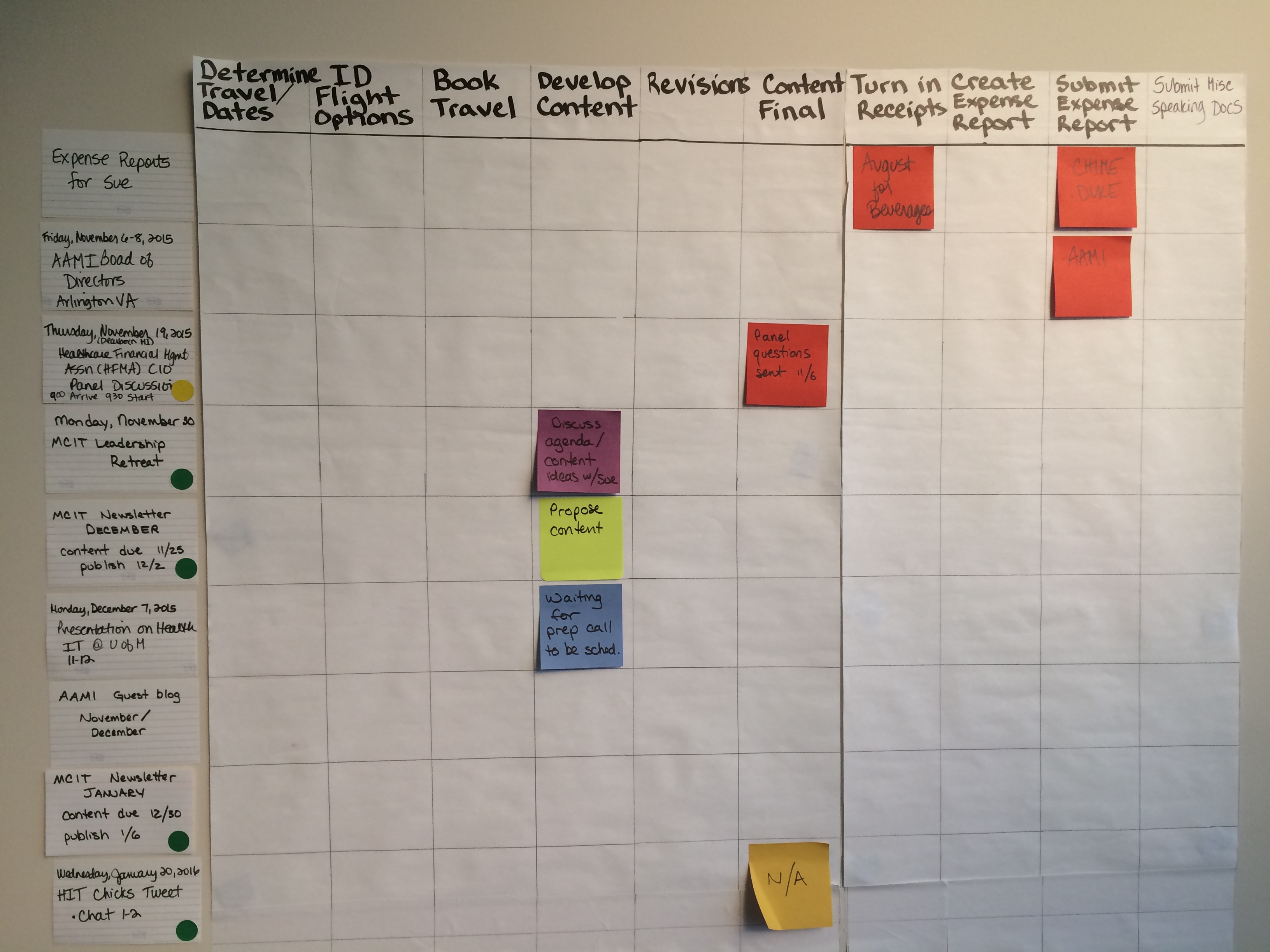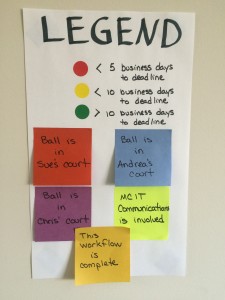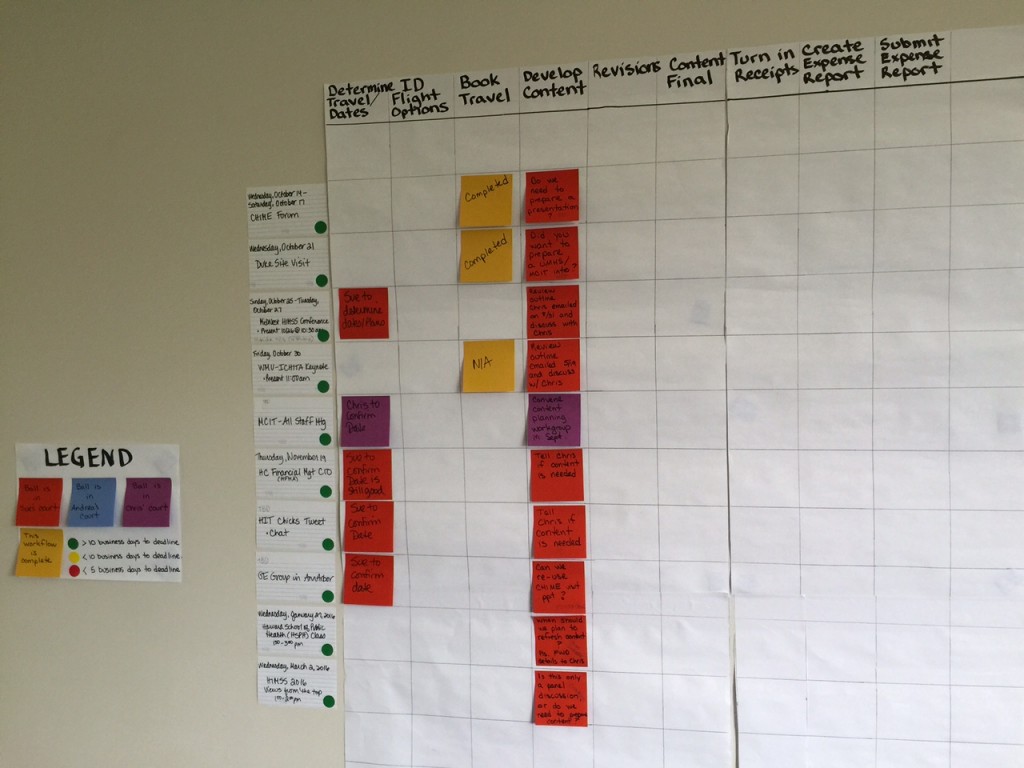 The past month has been a particularly busy one for me. I have spoken locally a few times and gone out of town on business several times as well. I’ve been to the CHIME Fall Forum, made a site visit at Duke, and attended an AAMI board meeting. During that same period, I’ve given a talk on “Women in Technology” and participated on a CIO panel at the Midwest Fall Technology Conference in Detroit. I spoke on “High Impact IT” at the 2015 ICHITA Conference sponsored by the Center for Health Information Technology Advancement at Western Michigan University in Kalamazoo. I was one of two CIO guests on the CIO TalkRadio Show last week. And we published our monthly newsletter and held one of our twice a year department all staff meetings.
The past month has been a particularly busy one for me. I have spoken locally a few times and gone out of town on business several times as well. I’ve been to the CHIME Fall Forum, made a site visit at Duke, and attended an AAMI board meeting. During that same period, I’ve given a talk on “Women in Technology” and participated on a CIO panel at the Midwest Fall Technology Conference in Detroit. I spoke on “High Impact IT” at the 2015 ICHITA Conference sponsored by the Center for Health Information Technology Advancement at Western Michigan University in Kalamazoo. I was one of two CIO guests on the CIO TalkRadio Show last week. And we published our monthly newsletter and held one of our twice a year department all staff meetings.
I have a busy schedule of meetings at multiple UMHS locations every day, so how did all these commitments come off without a hitch? The visual board my support staff and I started some weeks ago has made the difference! The only commitment that I scrambled on at the last minute was the one that hadn’t made it onto the board. That’s telling.
Prior to our visual board, I sometimes scrambled at the last minute to finish a presentation or finalize flight arrangements in time to get a reasonable price. Now, as a team, we can see into all the major events and commitments and take an organized approach to the shared tasks involved. The team I’m referring to includes my executive assistant, Andrea Smith; my staff specialist, Chris Greene, and me.

Our board is not fancy or complex. We use 3×5 index cards, color coded sticky notes, and colored dots. Each major activity/event is written on a 3×5 card and they form the “rows”. Standard tasks are the “columns”. The legend is simple: red sticky notes are my tasks, blue are for Andrea, purple are for Chris and lime is where our communications team gets involved. A green dot means the activity/event is more than 10 business days from now, yellow is 5-10 days and red is less than 5 days. At a glance, we can see where we need to focus our attention.
We review the board together at times. Some days I’ll just take a quick look before I head home and write updates on my red sticky notes. Andrea and Chris do their updates throughout the day and review it together as needed.
What do we think so far? Here’s what Chris has to say about it:
“I was excited about starting the board because sometimes it was hard to remember ‘Who’s on first?’ with all the different commitments. It is great to walk in and see exactly where each project is at, and who has the next step. Because we use color, I can tell instantly if I have a lot to do, and how soon. One unexpected advantage is handoffs. Our work is like a Venn diagram: there are three of us, and sometimes the work belongs to just one person, or two, or all of us together. Before the board, it wasn’t always easy to know this. Now, because we look at the board together, these handoffs and downstream impacts come up naturally in conversation.”
And Andrea says, “The visual board helps me when we are working on things as a group. I know who owns each task and I can look at the board to see the due dates.”
So why did we create this visual board? After seeing more and more examples of visual management at other companies along with having too many last minute scrambles, I started framing the idea with a few examples. I talked about how these examples could have gone smoother if we just had better coordination and a form of visual management. Andrea and Chris put their heads together and broke down the common tasks involved in our shared work and who typically does what – Chris helps with a lot of content and Andrea handles logistics.

It’s been key to experiment and not get stuck on perfection. Chris and Andrea used sticky flip chart pages and basic tools. Then they mapped it out on a wall in our suite, playing around with what format might work best. When I first saw it most of the sticky notes were red – my tasks!! They thought I’d be upset. But I wasn’t. We had to start somewhere and that’s where we were. I have to admit I’m happy when there are only a few red sticky notes and the red dot events are under control.
Chris has perspective about maintaining the board: “The biggest challenge is starting a new habit. Making and keeping up the board didn’t replace any work, it is new work. It does, however, make us more effective at the workflow it targets. The board is only useful if we take the time to update it.”
Other admins in the department have stopped by to learn from our experiment and consider how it would apply to working with their leaders. It is visible to anyone who comes to meet with me in our office suite.
Keep it simple but visual is my motto on this one!

Cindy Priddy on said:
Love it! Fits right in with what we’re doing in the Daily Management workshops. Especially appreciate the comments about the red dots – – reinforces the fact that visual controls are about driving improvement, not blame and shame. And agree with your motto — keep it simple and visual!
Sue Schade on said:
Cindy, go ahead and use example in the workshops. Attendees may not have seen the post. Agree it’s not about blame and shame. It’s about working together as a team and getting things done.
Jennifer Sporer on said:
I love this article, and may use these ideas myself!
Sue Schade on said:
Jennifer, feel free to stop by and check it out then figure out your own experiment.
M Hepner on said:
Very cool! Great idea.
Sue Schade on said:
Myron, stop by and check it out. Think you’ll find ways to apply it for your work.
Ron Blaisdell on said:
I suggest you convert this to Trello – http://trello.com – so that you can see & update the information remotely.
Sue Schade on said:
Ron, thanks for the suggestion. Trello looks like a tool worth checking out. As I replied to Jane just now, we are using a mix of tools in our IT department experiments depending on the particular situation. For the CIO office, with the three of us in close proximity and the nature of the activities being more long term work, having paper based visual board is working. Don’t really need the remote access at this point.
Jane Matson on said:
I find it ironic that a CIO is resorting to a solution that is an inefficient manual process and paper based. There are plenty of tools that would be more efficient than using hand-written sticky notes.
Sue Schade on said:
Jane, we are experimenting with many approaches in our IT department right now. Some with online tools and some with visual boards such as this. Online tools certainly help for virtual teams. We are finding the visual boards such as this are most useful when you have people who work in the same physical area and can easily come together to review issues and update progress as a team in real-time. I expect we will continue to use a mix of approaches to best fit the particular situation.
Drex DeFord on said:
Nice! Go visual systems! Good to see you a couple of weeks ag at CHIME…
Sue Schade on said:
Drex, thanks! Figured you’d appreciate this. Great presentation yourself on lean in IT at CHIME Fall Forum — very useful!
Barbara Zimdars on said:
As a visual person myself, I’m already thinking of ways this would help and can be applied. Great idea.
Sue Schade on said:
Barbara, good to see it got you thinking about ways to apply. Good luck!